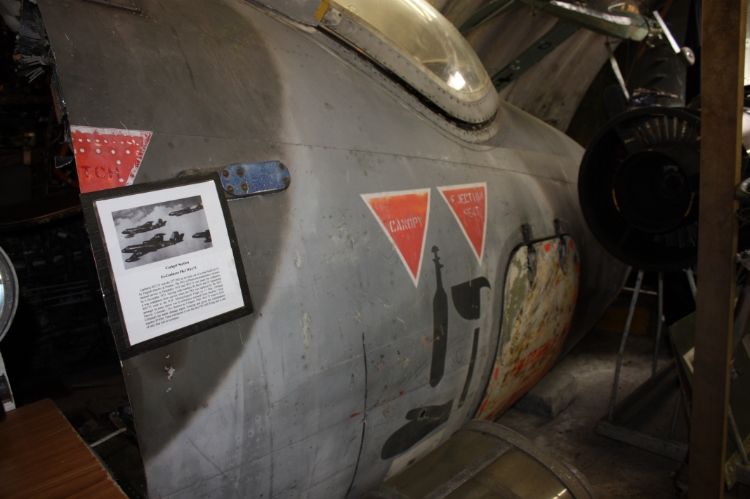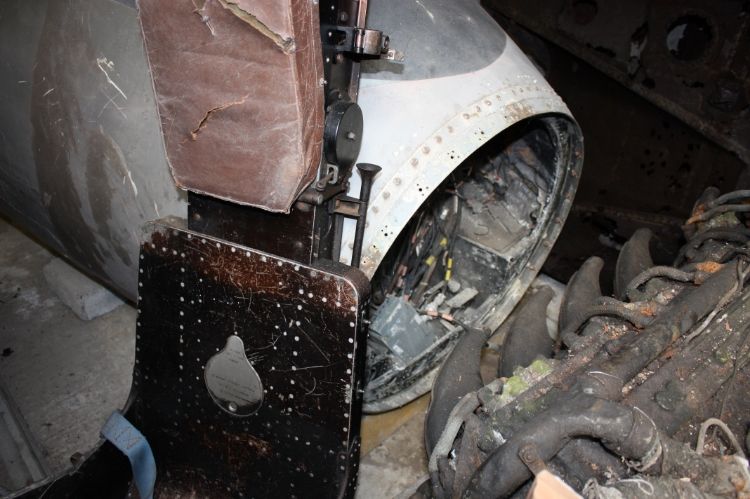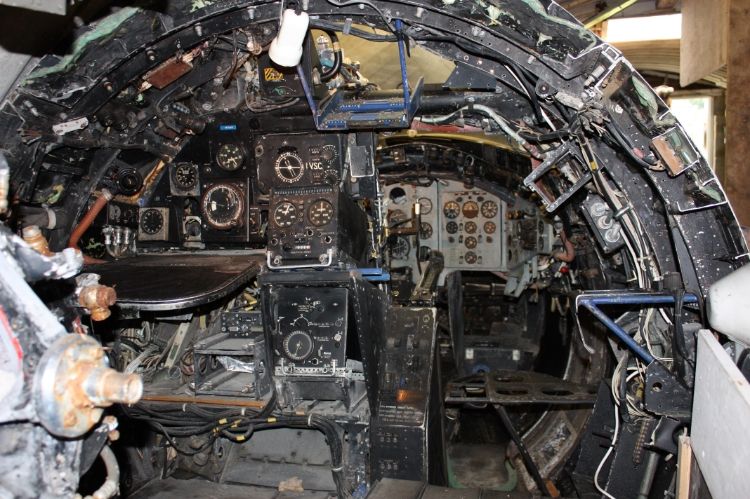Met Office : Research Flying
Sometime before 1981, a helicopter in the circuit at Farnborough reported to ATC that he had heard the MRF Canberra transmitting a 'mayday' call on 243 mhz. It had departed Farnborough some time previously for a research flight over the Bay of Biscay and indeed, this was where the 'mayday' call originated.
MRF aircrew weren't specialist aircrew, but were Hercules crew on detachment from Lyneham. On arrival at Farnborough, the pilots were given conversion training onto the Canberra.
Apparently what happened was, the pilot (name witheld) had somehow encountered a double flameout, but managed to land at a French military airfield having managed to re-light.
By the way, at Aldergrove in 1963 (long before it became Belfast International) there was a squadron of Hastings called the 'Met' Squadron (I think it was 208 but I may be wrong). Did these have any relationship to MRF?
MRF aircrew weren't specialist aircrew, but were Hercules crew on detachment from Lyneham. On arrival at Farnborough, the pilots were given conversion training onto the Canberra.
Apparently what happened was, the pilot (name witheld) had somehow encountered a double flameout, but managed to land at a French military airfield having managed to re-light.
By the way, at Aldergrove in 1963 (long before it became Belfast International) there was a squadron of Hastings called the 'Met' Squadron (I think it was 208 but I may be wrong). Did these have any relationship to MRF?
That was 202sqn. Halifaxes which were replaced later with Hastings.
They used some of the same instrumentation as MRF, but were managed from a different bit of the Met Office and had a rather different role. 202 were flying "meteorological reconnaissance flights" to provide daily inputs into the daily Met Office forecasts, whilst MRF was conducting research flying to support developing forecasting science.
G
They used some of the same instrumentation as MRF, but were managed from a different bit of the Met Office and had a rather different role. 202 were flying "meteorological reconnaissance flights" to provide daily inputs into the daily Met Office forecasts, whilst MRF was conducting research flying to support developing forecasting science.
G
Join Date: Jan 2007
Location: Australia
Age: 87
Posts: 56
Likes: 0
Received 0 Likes
on
0 Posts
Shackletons at 22,450
MRF coverage for Grapple was provided by the Shackletons on detachment. The MarkI's nose position with the specialised instruments was an extremely cosy workplace for the Met Observer. In fact, one of them on Grapple Z stated that the Shackleton had been initially designed for that purpose.
JohnB
JohnB
Tabs please !
Farnborough was the home of the MRF in the '80s before it relocated to Boscombe (I think).
The science on-board was rather whizzy. The laser pods under the wings could capture holographic images of ice crystals suspended in the atmosphere.
..... and then there was the chem trail tank for dispersing bromide over East Anglia......... only kidding.
The science on-board was rather whizzy. The laser pods under the wings could capture holographic images of ice crystals suspended in the atmosphere.
..... and then there was the chem trail tank for dispersing bromide over East Anglia......... only kidding.

Join Date: Jun 2000
Location: RAF Lincolnshire
Posts: 111
Likes: 0
Received 0 Likes
on
0 Posts
Elephant
Question I have is what happened to the elephant with the red and white nose that sat above the nav's station on the flight deck?
Another interesting read about met recce sqns is
"Even the Birds Were Walking" the story of wartime meteorological reconnaissance. John A Kingston & Peter G Racklife
Isbn 0-7524-2016-x
Had the great pleasure of meeting Peter at a MMU dinner in the mess at Scampton (well Kirton in Lindsy) several years ago.
Another interesting read about met recce sqns is
"Even the Birds Were Walking" the story of wartime meteorological reconnaissance. John A Kingston & Peter G Racklife
Isbn 0-7524-2016-x
Had the great pleasure of meeting Peter at a MMU dinner in the mess at Scampton (well Kirton in Lindsy) several years ago.
Thread Starter
Join Date: Feb 2008
Location: East Sussex UK
Age: 66
Posts: 6,995
Likes: 0
Received 1 Like
on
1 Post
For those interested ... here are the pics I took this afternoon of Canberra PR3 WE173 at the Robertsbridge Aviation Museum.
Robertsbridge Aviation Museum East Sussex



Unfortunately the nose section is missing and I assume the MRF livery was overpainted during her time on BDR Flight at RAF Coltishall. A bit sad to see but at least she has been saved from the Scrap Metal Man.
Coff.
PS. I salute the enthusiastic members of the RAM who have achieved so much with minimal resources.



Robertsbridge Aviation Museum East Sussex
Canberra WE173 was the 25th PR3 to be built out of a total build of 34 by EE at Preston. The PR3 entered service in December 1952 and WE173 was delivered to the RAF on 6th November 1953. She served with 82, 88, 69 and 39 Squadrons. WE173 was withdrawn from service when the PR3 was replaced by the PR7. WE173 then went on to serve with the MRF beginning 15th May 1969 and amongst it's many duties was involved in "turbulence research" from Buckley Field, Denver, Colorado, USA. She was retired on 4th March 1983. WE173 then went to RAF Coltishall for Battle Damage Repair training under Maintenance No 8740M. Upon retirement from MFR Ops she was the last PR3 still flying and is one of only four left in existence (albeit just a cockpit section now).



Unfortunately the nose section is missing and I assume the MRF livery was overpainted during her time on BDR Flight at RAF Coltishall. A bit sad to see but at least she has been saved from the Scrap Metal Man.
Coff.
PS. I salute the enthusiastic members of the RAM who have achieved so much with minimal resources.




The authors were: Kington, J. A. & Rackliff, P. G.
Kington was one of my lecturers when I started out [if I recall accurately] and I new Rackliff by sight.
Another stalwart of Met. Research was, I believe, Stan Cornford, who later became a magnificent Principal of the Met. Office College Shinfield Park, a gentleman and a great pleasure to serve under.
Kington was one of my lecturers when I started out [if I recall accurately] and I new Rackliff by sight.
Another stalwart of Met. Research was, I believe, Stan Cornford, who later became a magnificent Principal of the Met. Office College Shinfield Park, a gentleman and a great pleasure to serve under.
Join Date: Jan 2014
Location: Stoke-on-Trent
Age: 91
Posts: 366
Likes: 0
Received 0 Likes
on
0 Posts
Coffman,
Interesting pictures of R.A.M. I have passed the sign on many occasions while negotiating the A21, but have never visited. My brother-in-law is a member and, while talking to his brother just yesterday he mentioned the subject and informed me who the illustrious Chairman is, or possibly, was.
Interesting pictures of R.A.M. I have passed the sign on many occasions while negotiating the A21, but have never visited. My brother-in-law is a member and, while talking to his brother just yesterday he mentioned the subject and informed me who the illustrious Chairman is, or possibly, was.
Tabs please !
the Met. Office College Shinfield Park
The European Centre for Medium Range Weather Forecasting (ECMWF) received a new title. We called it Early Closing Mondays Wednesdays and Fridays.
A question for the ex-Canberra community ...
Would that Barbers Pole have likely caused any significant handling issues in asymmetric flight ... say on approach ? Presumably crews would have been required to undertake regular CT including asymmetric config ... just a genuine interest really.
Would that Barbers Pole have likely caused any significant handling issues in asymmetric flight ... say on approach ? Presumably crews would have been required to undertake regular CT including asymmetric config ... just a genuine interest really.
I discovered recently on looking at the Canberra at the Solway Museum at Carlisle airport that the leading edge of the fin is wooden. This was apparently so that it could be more easily trimmed during initial testing. It would thus be relatively easy to add a bit to the leading edge of the fin if necessary.
Thread Starter
Join Date: Feb 2008
Location: East Sussex UK
Age: 66
Posts: 6,995
Likes: 0
Received 1 Like
on
1 Post
Trim ...
That sounds very plausible, but it's quite difficult to judge to what extend the fin leading edge may have been so modified from the pics. Shame WE173 is just a cockpit section now. You never know ... someone may come up with more info
Kaitakbowler ...
There doesn't seem to be very much info on this tragic event readily available on-line. Given the Hastings "normal" service ceiling was published at 26,500 feet it would be interesting to understand what mods were made to the aircraft and what the crew life support arrangements were ... some form of partial pressure jerkin and pressure helmet perhaps ? Certainly the Taylor Helmet and PPJ, as used by Lightning pilots, was a later 60's technology.
Coff.
That sounds very plausible, but it's quite difficult to judge to what extend the fin leading edge may have been so modified from the pics. Shame WE173 is just a cockpit section now. You never know ... someone may come up with more info

Kaitakbowler ...
In November 1950 MRF suffered a tragic loss. Flt Lt K.L.Howard DFM, a member of the MRF aircrew, died in the Cambridge Military Hospital in Aldershot, as a result of "decompression collapse". This followed a flight to 30000ft in Hastings TG618 during an experiment to investigate the tropopause.
Coff.
Used to take JPs to 35,000 ft unpressurised. ISTR Canberra at 40,000 ft pressurised to 26,000 ft equivalent. Don't recall anyone getting altitude sickness, though common mountaineering at lower levels. Can anyone explain
Tabs please !
Not running around and breathing a higher o2 pressure than someone at sea level...... you probably felt terrific. 

Coffman,
the highest I can remember being in a Hastings was 22000 feet and neither the crew nor the a/c seem to enjoy the experience. Must have taken ages to get to 33000 feet. Perhaps chugalug with his Hastings experience can elucidate. Been to 35000 feet in a Herc on high level free fall trials. We had special oxy fit, and had to pre-oxygenate on the ground for an hour. It was very cold up there !
the highest I can remember being in a Hastings was 22000 feet and neither the crew nor the a/c seem to enjoy the experience. Must have taken ages to get to 33000 feet. Perhaps chugalug with his Hastings experience can elucidate. Been to 35000 feet in a Herc on high level free fall trials. We had special oxy fit, and had to pre-oxygenate on the ground for an hour. It was very cold up there !
Join Date: Oct 2000
Location: South Central UK
Posts: 254
Likes: 0
Received 0 Likes
on
0 Posts
To return to the original question, I cannot recall any non-standard, asymmetric operating procedures for WE173. I only flew it on a few occasions, cannot remember why, but guess MRF were short of their own Canberra qualified pilots for some reason.
The Pershore/Bedford Canberra fleet had some more extreme nose configurations!
lm
The Pershore/Bedford Canberra fleet had some more extreme nose configurations!
lm
Join Date: Jun 2007
Location: West of Akrotiri & the B Sours
Age: 73
Posts: 95
Likes: 0
Received 0 Likes
on
0 Posts
Used to take JPs to 35,000 ft unpressurised. ISTR Canberra at 40,000 ft pressurised to 26,000 ft equivalent. Don't recall anyone getting altitude sickness, though common mountaineering at lower levels. Can anyone explain.
The Canberra, in common with many, had a pressurisation schedule of half the altitude plus 2000. So at 45,000, the cabin alt was 24,500. Mild decompression can start at 18,000 and it was common to get "aching joints and shoulders" on long transits.
The Canberra, in common with many, had a pressurisation schedule of half the altitude plus 2000. So at 45,000, the cabin alt was 24,500. Mild decompression can start at 18,000 and it was common to get "aching joints and shoulders" on long transits.
Flew some of the Pershore based fleet in mid 60s - don't recall any nose-profile related issues - but then I am not sure what I had for breakfast. "Breakfast" - what's that?





